Mold Testing & Remediation - Mobile, AL & the Mississippi Gulf Coast
On the subject of mold remediation, and mold information in general, it is ServiceMaster Advance's quest to educate our customers and the public as much as possible. There is a lot of information published about mold. We believe the consumer should educate themselves, and obtain information from a variety of sources. We believe that after the consumer has done their homework, they will clearly understand why our approach is one of extreme caution, with the health of the individual as our first and foremost concern.

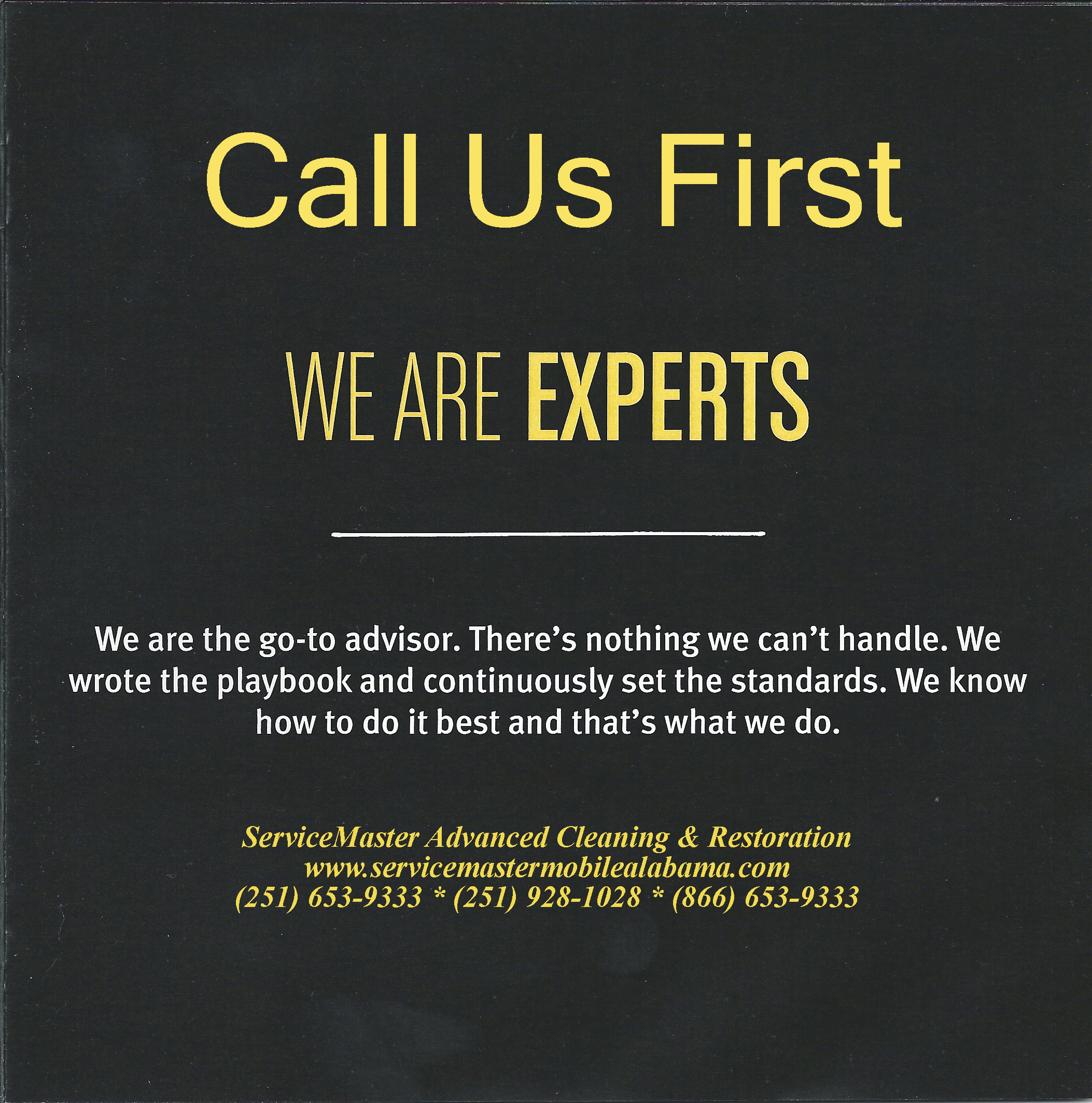
Before You Hire A Mold Remediation Company, read this.
CERTIFIED Mold Remediation Requires Training & Knowledge
If you have a mold issue, make certain that you hire a CERTIFIED mold remediation professional. Ask to see their certifications. Ask to see their insurance. Mold can be a serious health hazard, and you shouldn't take a chance with anyone that says it can simply be torn out! The airborne spores left from the removal of affected drywall and contents, are typically the very thing that will cause health problems. If every square inch isn't properly cleaned and the air filtered, the resulting spores can be enough to cause serious health issues. We will not take a chance with your health. We only know one way to do the job - the right way. This involves total elimination and removal of all visible and airborne mold spores. - ServiceMaster Advanced - The Master of Disaster (251) 653-9333, (251) 928-1028.
In this posting, we have combined several articles. We hope you find them helpful.


Mold spore counts are typically collected through a air sampling machine such as this one.
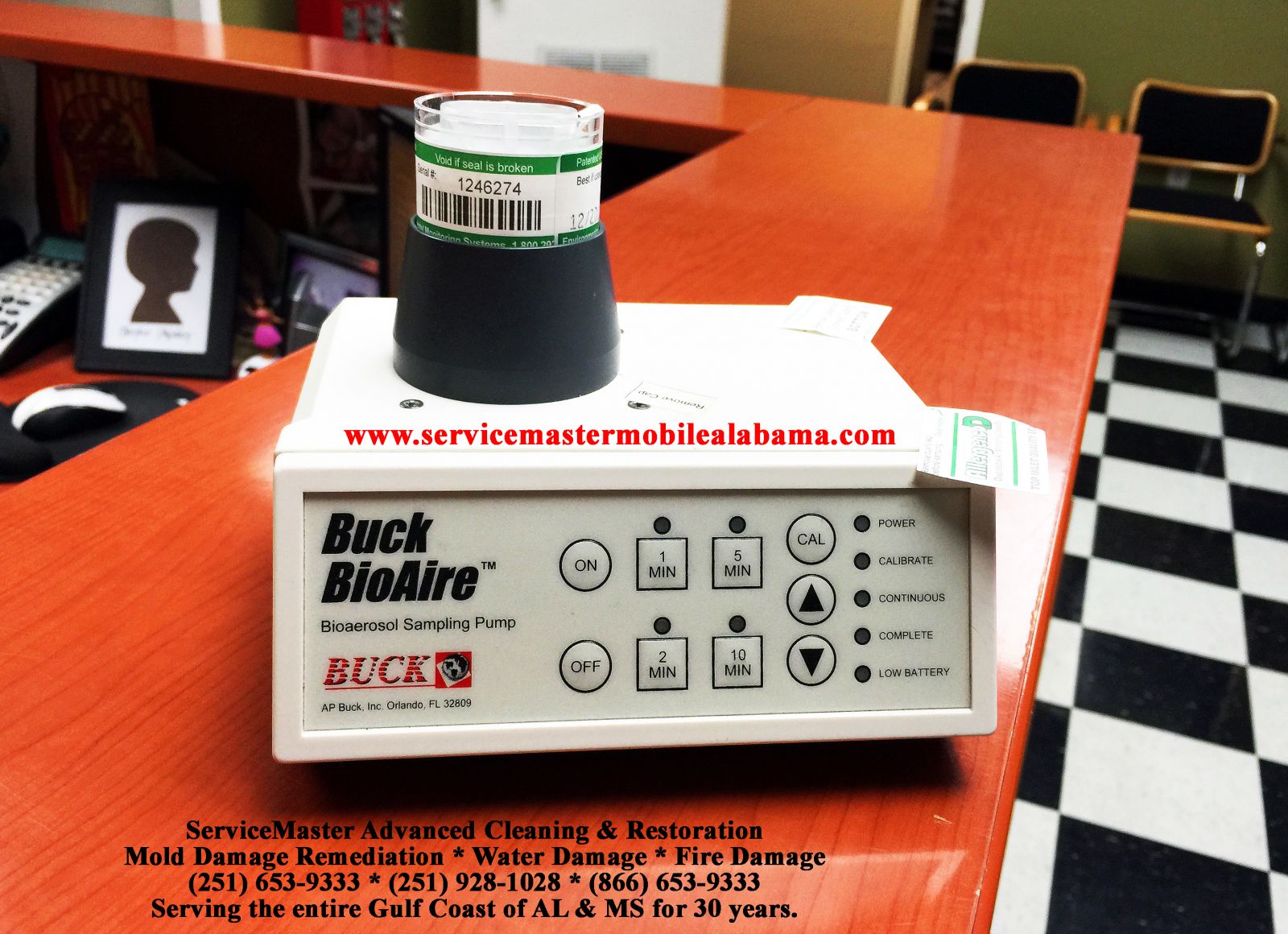
ServiceMaster believes in doing mold remediation the right way. This means calling in an independent Industrial Hygienist and having the customer hire them to do “before and after” air sampling, and write a proper mold remediation protocol. Typically, collection of air and or tape samples will be done. Here is an initial report prior to remediation:
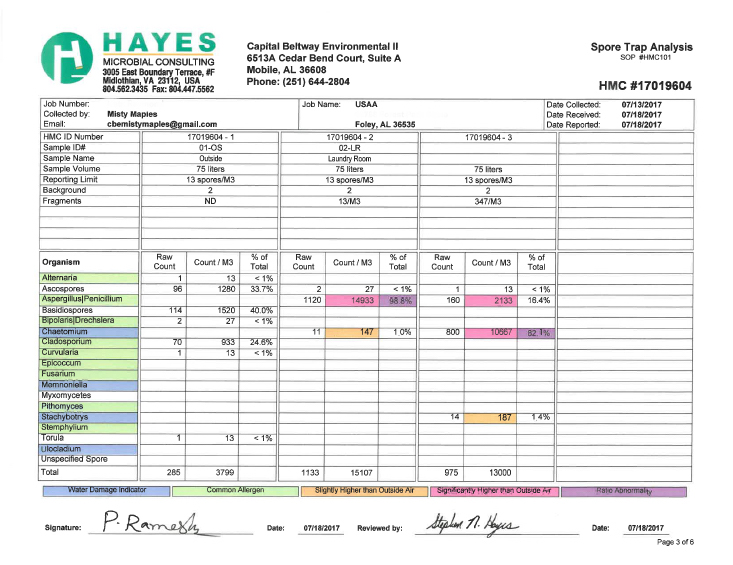
At this point, a proper mold remediation protocol will be written. This is an extensive, SPECIFIC document, detailing exactly what will be done. Specifically, which walls need to be removed, which areas can be cleaned, the duct work to be cleaned and where containment should be set up. Since these documents are quite lengthy (often several pages), we have elected not to include a sample document in this article. We will gladly provide one for a prospective customer.
After the protocol has been followed to the letter, and the remediation has been completed, then the structure is retested. Here is an example of the same structure as above, after mold remediation is completed:
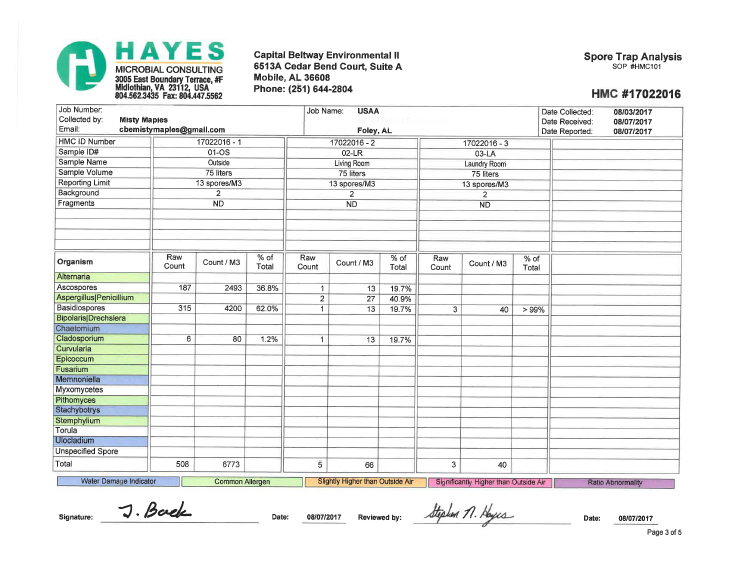
Close examination of the air samples collected and the report issued, are indicative of nearly complete removal of all mold spores. in fact, the air inside is now cleaner than the outside air!
There are companies that do not adhere to these standards. While we do not view them as competition, nonetheless we have seen customers come to us after having been "sold" by one of these entities. The customer who sent us this, was very disappointed. Pictures were provided to us of VISIBLE mold that they missed after THREE visits! Here is an example of one company's approach to market, which on the surface, may seem appealing to the unsuspecting homeowner.
Below is a copy of this company’s warranty as sent to us, complete with their language and typos. If you read carefully, you are given a one-year warranty (included in the initial price); any additional years are sold for a price. IF your thermostat is set too high and/or you have a subsequent water intrusion, the warranty may be null and void.
IF the work is done properly initially, and verified by a CERTIFIED industrial hygienist, who does air sampling and sends said samples off to a lab for testing, then there is no need for subsequent visits. Either the job is done right, or it isn’t. MOLD DOES NOT GROW BACK WITHOUT THE PROPER CONDITIONS, ONCE IT HAS BEEN REMEDIATED. Any unattended and unmitigated subsequent water intrusion may indeed cause subsequent mold, which this company likely will not remediate as a part of their warranty. You are paying for a warranty for, what? So they can come back at your expense (the cost of the warranty) if they missed something, or at your expense if something additional happens. Clever.
Also, while we cannot show you their protocol written for this customer, it mentions cleaning the HVAC system with a biocide, and a "residual" (whatever a residual is - we assume it to mean that they will LEAVE a residual amount to the biocide in the HVAC ducts). Nowhere does it mention the type of HVAC Cleaning that ServiceMaster does. Our method involves inserting a rotary brush and vacuum and PHYSICALLY cleaning the entire duct work with a biocide. This ensures that all mold is physically removed from the ducts. Next, the system is sealed to ensure that no remains spores are loose and still floating, and that there is no chance for recontamination. This method ensures that all mold is removed and there is no need for us to continually reinspect (for a fee), as the company below is "offering" to do under their annual contract. In fact, if a customer has a subsequent event, ServiceMaster is always willing to revisit - free of charge. We do not need to rope you into an annual contract, and we stand by our work - which will be done right the first time and verified by an independent lab.
Here is their pitch:
Our remediation protocol provides A ONE YEAR RENEWABLE WARRANTY which will be issued upon completion and payment of remediation and decontamination. A sample of this warranty is attached. This warranty is transferable if this property is sold.
ONE YEAR RENEWABLE WARRANTY
PREMISES FOR :
SAMPLE
LOCATION :
This warranty is being issued for Mold Remediation and Decontamination Services that were performed on the above named property on <Insert Date>
<Company Name> Services agrees to perform a QUARTERLY inspection of this property. <Company Name> agrees to re-apply a Biocide and Residual Treatment during these inspections.
<Company Name> Services agrees to remediate all detected areas of mold relating to this current event but not to cover new events, during the warranty coverage period of one year. This includes but is not limited to :
Furniture Furnishings
Equipment Appliances
Interior wall surfaces and trim Interior windows
The HVAC System will be treated with a Biocide and Residual at the time of the quarterly inspections.
The property owner, agrees to :
It is recommended that you maintain a setting of NO HIGHER THAN 74 DEGREES on ALL air conditioning thermostats.
Repair or replace ALL broken air conditioning units IMMEDIATELY.
nspect (sic) for and repair all leaks IMMEDIATELY. <Company Name> Services is to be notified immediately in the event of any leak or other moisture intrusion.
FAILURE TO COMPLY WILL RESULT IN THIS WARRANTY BECOMING NULL AND VOID.
END OF ARTICLE

Not All Mold Remediation Is The Same (Part 1 of 3)
There is a growing awareness that when certain individuals become ill from the contaminants in a water-damaged-building (WDB), their bodies develop sensitivity to those specific pollutants, as well as to other compounds. In such cases “normal” remediation or cleaning does not result in an environment that is helpful or acceptable to the client. With new studies showing that up to 25% of the population could be genetically susceptible to this type of exposure ailment, it is crucial for both restoration contractors and the impacted people to know how to approach such problems so that any remediation or ancillary cleaning has the best chance of success.
Looking for Mold-Related Health Answers in all the Wrong Places
People who have been sickened by mold or who have been assisting in the restoration and repair of water-damaged buildings have seen it over and over again. The musty odor or visible fungal growth often produced by water damage can cause greatly varying problems from person to person, despite similar occupancy patterns. Some individuals become debilitated, and somehow know that it is the structure that is causing their problems. In contrast, a much greater number of similarly exposed people experience minor symptoms or none at all!
Such situations do not fit a typical risk assessment from a safety and health standpoint. Training in the arena of chemical exposures teaches that there is a dose/response relationship. We are conditioned to expect that a higher dose of an offending compound is more likely to impact a greater number of individuals with more severe symptoms. However, when contamination situations do not fit that familiar pattern some investigators (and in this case, most of the mold control industry) fail to consider other possibilities and lazily fall back on the psychosomatic excuse for the sick people: “It’s all in their heads.”
This grip on the classic industrial hygiene approach to illness has led to a large number of narrowly focused research efforts that tried to force the “mold problem” back into the dose/response box. In particular, there have been extensive attempts to quantify occupant exposure levels to various mycotoxins. Although it has been known for centuries that various fungal organisms create chemical compounds that are poisonous to other organisms (think of toxic mushrooms and antibiotics derived from Penicillium mold that kills bacteria), many carefully controlled studies failed to show that occupants in water-damaged buildings could ever inhale or ingest enough of these toxic substances to reach a threshold of harm.
Sadly, that research was hindered by two assumptions that, even today, keep many mold remediation professionals from seeing the big picture of health effects from water-damaged buildings. The first supposition that impacted the data is the one that we mentioned previously—the dose/response expectation as the root of the symptoms. This was compounded by a narrow focus on mycotoxins as the serious culprit, almost to the exclusion of the irritant effects of fungus-generated gasses and the allergenic nature of microscopic spores and fragments. An even broader effort would look beyond mold and realize that any wet environment supporting fungal growth is also harboring bacteria and a host of other microorganisms.
Medical Science Explains Some Anecdotal Data that Occupants and Remediation Professionals Have Long Puzzled Over
What if the reaction of some people to a water-damaged building is not related to the standard dose/response model of exposure illnesses? To further complicate things, what if different organisms in wet environments affected people in a variety of ways? Once doctors and scientists moved in that direction, the search was on to identify mechanisms that trigger symptoms and to figure out what separates ill individuals from the majority that do not exhibit the same symptoms.
Taking a broader view led many researchers back to the idea that wet interior environments provide a suitable home for more than just mold. Research reports began filtering in that suggested that some symptoms reported by individuals in water-damaged buildings could be the result of combined exposure to both bacterial and fungal materials. In June of 2012 scientists participating in a long-term study of environmental health effects in the Cincinnati area reported that they identified two specific types of bacteria in water-damaged buildings that, in conjunction with mold, increase the negative health effects experienced by occupants.
A new look at the allergenic nature of mold exposure was also necessary when some physicians moved beyond the dose/response relationship and began investigating whether particular fungal contaminants could be sensitizers, in contrast to the typical approach where more exposure equates with worse symptoms. This alternate concept was supported by a 2012 study of items that impact indoor environments, which concluded with a list of 374 known asthmagens, identified by government agencies, third-party regulatory agencies, and academic sources. The report used the term “asthmagen” instead of “allergen” to emphasize a growing recognition that even contaminants that do not typically evoke an allergic response can be asthma triggers.
Occupant sensitization is now recognized as a significant problem by both government agencies and the private sector. In essence, scientists and doctors now realize that sensitization can occur in situations where it was never anticipated in the past. Now, some of the puzzle pieces seem to be fitting together. Some individuals exposed to mold and other contaminants in water-damaged buildings will develop symptoms that conform to an allergic response. For those with an allergy to mold, elimination of exposure by either leaving the structure or remediating the problem generally results in self-healing and resolution of symptoms. However, individuals who become sensitized experience ever-increasing levels of symptoms even with smaller and smaller exposures. In the worst cases, even removal of the offending contaminants does not lead to an improvement in symptoms.
Once the idea of sensitization was validated, many of the difficult-to-explain symptoms made sense because they were the result of an innate immune response illness (symptoms triggered by processes in the body itself) rather than an acquired immune response illness (symptoms triggered by an invader from outside the body). In layman’s terms, exposure to water-damaged buildings causes some people’s immune systems to go into overdrive and not shut off—even after the trigger contaminants are reduced to minute levels. Such responses have been labeled biotoxin illness, or more precisely, chronic inflammatory response syndrome (CIRS).
Finally, in the last few years DNA sampling has been instrumental in explaining why certain people in a water-damaged building will develop CIRS and others will not. There is now solid evidence validating the hypothesis that nearly a quarter of the population has a genetic susceptibility towards CIRS if they have a significant exposure to mold and other contaminants in water-damaged buildings. As a result, some people never get sick and others, who are genetically susceptible, get sick with seemingly trivial exposures.
What Does this Mean to Occupants and Remediation Contractors?
While these particulars about allergens, asthmagens, sensitization, CIRS, and WDB may seem inconsequential, they actually have a direct bearing on remediation contractors. One of the biggest issues is the realization that the standard classes of occupants thought to be most susceptible to mold probably are not. Training for fungal remediation routinely emphasizes that infants, the elderly, and those with pre-existing health problems are at greatest risk during a remediation effort. While those individuals should surely be protected, it can just as likely be healthy adults who develop a myriad of life-altering symptoms from exposures in a water-damaged building, simply because of their genetic makeup.
In these situations, professionals always look for a simple, inexpensive test to help identify who might be at the greatest risk. Incredibly, that hurdle may have been surmounted by the adaptation of a standard vision test called visual contrast sensitivity. Although the test was originally developed for identification of other diseases such as glaucoma, it was found to also be useful for diagnosing systemic illnesses such as diabetes. It has now been adapted to the point where many physicians claim that it can be an accurate assessment of the overall effect of neurotoxins on a patient’s system. According to multiple reports, for people who report potential exposure to water-damaged buildings, failing this test is a strong indicator of a biotoxin illness, with a diagnosis accuracy rate of about 92%.
This is one of the major reasons there is an evolving trend for restoration professionals to be responsible not only for removing contamination, but also for conducting complete structure cleaning, and even completing the repair/rebuild to minimize future problems. While it is true that many hygienists and contractors limit their scope of work based on cost factors and deal only with visible fungal growth, this tactic does not resolve the problem for sensitized individuals. In those cases, the contamination situation in a building that has been water damaged must be viewed as having four distinct components to be managed:
Sources of fungal contamination (both visible and hidden)
Transport mechanisms that allow spores to migrate from one area to another (with HVAC systems being the most important)
Contents such as clothing, furniture, and personal belongings that have become sources of contamination because they are supporting fungal colonies or have been cross contaminated with spores and other fragments
Reservoirs of fungal spores and fragments in the structure (carpets, walls, ceilings, and many other surfaces)
Unless all of these aspects of the fungal contamination issue are addressed, relief of symptoms by the occupants will often remain elusive. Continue reading Part Two…
Not All Mold Remediation Is The Same (Part 2 of 3)
This is part two of three, please read part one if you have not already so.
Proper Removal of Fungal Sources is Not Rocket Science—But Must be Science Based
Currently there are very few federal or state regulations that actually control the mold remediation process (Texas being the notable exception, but even in that state there is a current push to deregulate those activities). Therefore, true industry professionals must be aware that their efforts are subject to an industry standard of care. Unlike a regulation, a standard of care must be pieced together from a number of different documents. While there is some debate about which references really form the core of the mold control industry, the following seven documents are cited frequently:
1. American Conference of Governmental Industrial Hygienists; Bioaerosols: Assessment and Control; 1999
2. American Industrial Hygiene Association; Report of Microbial Growth Task Force; 2001
3. Environmental Protection Agency; A Guide for Mold Remediation in Schools and Commercial Buildings; 2001
4. Canadian Construction Association; Mould Guidelines for the Canadian Construction Industry; 2004
5. New York City Department of Health; Guidelines on Assessment and Remediation of Fungi in Indoor Environments; 2008
6. Institute of Inspection Cleaning and Restoration Certification; Standard and Reference Guide for Professional Mold Remediation S520; 2008
7. Occupational Safety and Health Administration; A Brief Guide to Mold in the Workplace; Safety and Health Information Bulletin, updated November 2013
Despite the fact that guidance for mold situations is coming from a variety of sources, there is a surprising consistency in the overall tone and approach. Since many mold remediation contractors come from a background of dealing with other hazardous contaminants such as asbestos or lead, all of the accepted reference documents emphasize understanding that mold is a biological agent. Since it has the ability to grow under the right conditions, isolation and deferred action to remove the source of the problem may not be possible, as it is with asbestos materials. With mold a delay may allow contamination inside a building to grow to a point where it poses a hazard greater than when initially discovered.
Another key point emphasized by all of the documents is that the presence of mold growth means that there is or has been moisture intrusion in the building. Removing surface mold contamination and not identifying and correcting the underlying moisture problem would be tantamount to a doctor treating symptoms rather than the disease that is causing them. This aspect of the mold remediation process has taken on even greater importance since we have recognized that other contaminants present in water-damaged buildings are also contributing to the problems experienced by occupants.
A third element that makes up the standard of care for the removal of fungal sources is that the work be done in such a way as to avoid cross-contamination. As is stated in bold type at the beginning of the remediation section of the New York City guidelines: The goal of remediation is to remove or clean mold-damaged materials using work practices that protect occupants by controlling the dispersion of mold from the work area and protect remediation workers from exposures to mold.
Even though it should not be necessary to add this warning, a word about chemical use is important. Too many advertisements related to mold remediation fall into the category of “spray and pray.” Despite the fact that the advertisements and sales pitches talk about how the product is “all-natural,” “developed by NASA for the space station,” “used by the military to decontaminate anthrax,” and a number of other impressive statements, such an approach does not fit the industry standard of care. More important, fogging, spraying, or atomizing chemicals into a structure occupied by a sensitized individual can be downright dangerous. Spraying such materials into a building and praying that they take care of the problem the first time, divert energy and financial resources away from the real work of physical removal of fungal sources and reservoirs.
The Basics of Source Removal When There are Sensitized Occupants
Proper isolation, engineering controls, and work practices must be employed on every project focusing on contaminant removal from water-damaged buildings because bad remediation can be worse than no remediation at all. Activities that disturb sources of biological growth and distribute bacteria, spores, fragments, and byproducts such as mycotoxins into the air where they can migrate to other areas of the structure must be done under controlled conditions. While failure to understand or follow this standard of care may create some problems for the average individual, conducting such work without proper controls can literally create a life-threatening situation for one who is genetically susceptible or previously sensitized to contaminants from water-damaged buildings.
Although entire books have been written on proper remediation, a typical project involving individuals who have known or suspected mold sensitization utilizes these sequential steps:
A. Isolation from the rest of the structure of the specific work area where visible or hidden contamination will be removed, utilizing sheet plastic or other materials sealed tightly against structural components.
B. Sealing off of supply and return air ducts for the duration of the remediation effort.
C. Installation of a decontamination chamber that acts as both a transition zone between the contaminated work area and the rest of the structure and a device that controls the amount of air flow into the workspace.
D. Creation of negative pressure inside the isolated workspace through the use of exhaust fans. In most cases the exhaust air is pushed through HEPA filters before being exhausted out-of-doors in order to create a pressure differential of 0.02” of water column (equivalent to 5 pascal).
E. Minimization of spore deposition through HEPA vacuuming or sealing of visible mold with adhesive plastic prior to disturbing the visible colonies.
F. Careful planning of the demolition aspects of the work so that sections of drywall or other finish material are kept small enough to fit into bags without having to be broken.
G. Requiring individuals working inside the isolated area to wear protective suits with hoods, slip-on safety boots, gloves, and respiratory protection is an important means of preventing cross-contamination. When the workers remove those items in the decontamination chamber it keeps contaminants from being carried into other areas of the building.
H. Utilization of dust free demolition techniques, such as panel saws with a dust collection cowl around the blade, connected to a HEPA-filtered vacuum for cutting of plaster or drywall.
I. A work sequence that follows the air flow, generally starting at the decontamination unit and finishing at the area closest to the negative air machine.
J. Immediate bagging of debris and careful attention to frequent cleanup of dust with a HEPA vacuum.
K. Wiping plastic bags of debris at the entry to the work area and then double bagging the material in the decontamination unit into bags that have never been inside the work area.
L. Transport of double bagged debris out through occupied areas of the structure in solid containers with tightfitting lids, such as Rubbermaid garbage cans.
M. Thorough cleaning of the isolated work area following the removal of all contaminated materials, using the “HEPA sandwich,” a three-step process consisting of HEPA vacuuming, damp wiping with an antimicrobial, and a second HEPA vacuuming.
N. Air scrubbing for 8 to 24 hours following completion of removal and cleaning activities. During this air scrubbing one HEPA-filtered unit should be used to maintain negative pressure, with a second unit set up inside the isolated work area with an exhaust tail to diffuse the air.
Dealing With the Often Forgotten Transport Mechanism
Although it seems difficult for the layperson to imagine, many remediation projects in water-damaged buildings emphasize sealing the supply and return vents in the isolated work area with poly sheeting and then simply allow the plastic to be removed after successful sampling results are received. No testing or cleaning of the register vents, ductwork, or mechanical components of the heating, ventilating, and air conditioning (HVAC) system is ever considered. Given that the microscopic particles that cause so many problems for sensitized individuals are present prior to the remediation effort, the default position should be to consider all HVAC mechanisms to be contaminated and in need of cleaning rather than being ignored.
Proper cleaning of HVAC systems is a sub-specialty, even in the remediation field. While many service providers claim to clean ductwork, few have the equipment and experience to do it well when the work is part of a remediation process in a water-damaged building with sensitized individuals. A thorough understanding of the cleaning guidelines put out by the National Air Duct Cleaners Association (NADCA) is a bare minimum starting point.
Above and beyond the basics, sensitized individuals require a thorough cleaning of the HVAC system that typically involves isolation of all supply and return points. Negative pressure is then installed at the mechanical unit, with the preferred method being a van- or truck-mounted filtration device connected to the HVAC unit by a long flexible duct. One at a time, starting at the supply and return vents farthest from the mechanical components, the grilles are uncovered and cleaning brushes, wands, or other specialized equipment is inserted into the ductwork. This process dislodges contaminants and pushes debris and microscopic impurities downstream, where it can then be sucked to the outside capture device in the specially-equipped vehicle.
Duct cleaning in the homes of sensitized individuals adds a number of complexities that are not present in the typical project. There is significant debate in the HVAC cleaning industry about the practicality and effectiveness of cleaning flexduct (polyethylene tubing that has spiral wire ribs in it—like a Slinky toy—that allow it to expand and contract). For occupants suffering from biotoxin illness or other sensitivities that are triggered by microscopic contaminants, it is best to remove and replace flexduct as part of the cleaning process. Such clients should also have the fan and coils actually disassembled from the unit. Although this requires the use of a licensed mechanical contractor, it allows those critical pieces to be taken outside and thoroughly cleaned, while enabling access to inspect and completely sanitize the drip pan and associated piping.
If the main trunk lines are constructed of fiberglass duct-board rather than sheet metal, a thorough cleaning will roughen the interior surface. Unless addressed at the time of the cleaning, the damaged interior will shed more particulates when the system is used and provide many more areas where moisture can be trapped and support future fungal growth. Therefore, as much as excess chemical use is avoided in homes with sensitized individuals, this is one situation where application of a low odor, EPA-approved coating inside the ductwork is imperative as part of the cleaning process.
The use of spray or gaseous sanitizers in ductwork as an adjunct to cleaning is also controversial. For sensitized individuals, the general industry preference is to avoid adding additional chemicals to the HVAC system—even those that are expected to quickly break down to inert materials. As noted in the remediation section, the focus of the cleaning should be on removing the small particulates to as low a level as practical, not on killing or inactivating the contaminants.
Not All Mold Remediation Is The Same (Part 3 of 3)
This is part three of three, please read part two if you have not already so.
The Contents Conundrum
Despite many statements to the contrary, most contents from water-damaged buildings can be salvaged and cleaned to the point where they are safe for even the most sensitized individual. Therefore, the more relevant question is not whether the contents can be cleaned, but, can the contents be cleaned thoroughly at a price that makes it financially feasible?
Two key pieces of information need to be reviewed when dealing with contents: the type of material to be cleaned, and whether the contamination is actual biological growth or rather deposition of spores and fragments. This means that sorting and inventory are the main tasks at this step in the remediation operation. The following table, summarized from a more detailed article (Wonder Makers Environmental; “Recommended Cleaning Practices for Materials Potentially Contaminated by Mold”; July 2001), describes many of the techniques currently available for addressing contaminated contents for sensitized individuals, and provides a great starting point for the sorting.
|
Type of Material |
Spore Deposition |
Visible Growth |
|
Porous: Fabric, paper, upholstered furniture, clothing, etc. |
Air washing for documents, HEPA sandwich cleaning (HEPA vacuum, hot water extraction with drying and HEPA vacuum), dry cleaning (chemical residue may be a significant problem), specialized laundering such as Esporta |
Disposal and replacement unless high value, then specialized restoration such as freeze drying papers and HEPA sandwich clean, specialized cleaning of furs, etc. |
|
Semi-porous: Raw wood, furniture, etc. |
HEPA sandwich cleaning, HEPA vacuuming with stiff bristle nozzle; may also include surface sealing after cleaning and inspection |
Disposal and replacement if structural damage or significant rot; scraping, scrubbing, sanding, or abrasive blasting if surface contamination followed by HEPA sandwich cleaning |
|
Non-porous: Metal, plastic, glass, sealed wood, etc. |
HEPA vacuuming, wet wiping, washing, power washing, air washing, air blasting |
HEPA vacuuming, scrubbing, immersion washing, ultrasonic cleaning, power washing, air washing, air blasting, steam cleaning |
|
Specialty items: Paintings, photos, electronic goods, taxidermy displays, sculpture, artwork, oriental rugs, etc. |
HEPA vacuuming in conjunction with air washing; disassembly, cleaning with deionized water, drying |
Professional, specialized restoration |
Cleaning of non-porous items is fairly straightforward. Soft goods pose a greater challenge because contaminants can become infused throughout the entire item. The more layers that make up the porous item or the bulkier the material, the more difficult cleaning and verification of the cleaning become. The ever-increasing variety of fabrics and materials that are used for soft goods compounds the problems because certain cleaning techniques are only appropriate or effective for specific materials.
Fortunately, there are some proven technologies for dealing with contaminated contents. One technique that has been demonstrated to be effective is known as the HEPA sandwich. This process involves three steps, with vacuuming being the first and last activity. In between, some form of wet cleaning is utilized, such as damp-wiping, washing, or hot water extraction. While this HEPA sandwich approach has been used extensively for cleaning non-porous or semi-porous building surfaces, it has also been employed successfully for a number of porous materials. For example, carpet that is impacted by deposition of mold spores but is not supporting visible colonies of fungal growth has been efficiently cleaned by HEPA vacuuming before and after a professional hot water extraction of the floor covering. Thousands of pieces of upholstered furniture have also been successfully saved using this method.
Removing the Reservoirs
Perhaps the most common error affecting sensitized individuals who go through a mold control process is the determination of whether or not cleaning is necessary in areas of the structure outside the isolated remediation work area. While detailed cleaning of an entire structure may not be necessary for individuals who are reacting to the water-damaged building with a typical allergic response, additional cleaning is almost always necessary for those who are suffering from biotoxin illness.
The fact that mold and other contaminants were growing in the structure to the point that it triggered or exacerbated a health problem, means that contaminants and reservoirs exist in other areas of the structure. This was graphically demonstrated by the EPA through the development of their Environmental Relative Moldiness Index (ERMI) sampling process. Their studies showed that a good indication of whether any structure had suffered water damage could be obtained from a single dust sample of the flooring.
Building on that government work, there is a growing body of evidence from carefully controlled medical studies that dust samples can be used to predict health concerns for sensitized occupants. One well-known physician, Dr. Ritchie Shoemaker, has even identified core components of an ERMI sample that specifically correlate with health. He compares ERMI-style dust sample results to a score sheet to provide his patients with information about whether a particular space is suitable for their occupation. This process is now migrating to an evaluation of the structure following remediation.
Despite not being high-tech, the primary method of removing reservoirs of contaminants from building surfaces is detailed cleaning. Every square inch of the surfaces in the structure are cleaned using HEPA vacuums (sealed and tested with a particle counter to ensure that they are not spreading dust around rather than collecting it), microfiber cloths, and carefully selected cleaning agents. This work is supplemented by air washing (directing compressed air across the surfaces toward an exhaust fan) and air scrubbing (recirculating air through a HEPA-filtered device). Sometimes fogging with water or non-toxic solutions is also utilized to help lift particles from surfaces and give them greater mass so that they are more easily captured.
A Word About Ozone
A number of contractors are now pitching the process of “treating mold in place” with high levels of ozone instead of removing contaminated materials in a controlled and careful way. They have expanded their promotion to include ozone flooding of structures after remediation as “insurance” against problems from hidden sources. This is bad for normal occupants and could be devastating for the sensitized individual. This approach is so far out of bounds that the New York City guidelines use this pretty clear language:
The use of gaseous, vapor-phase, or aerosolized (e.g., fogging) biocides for remedial purposes is not recommended. Using biocides in this manner can pose health concerns for people in occupied spaces of the building and for people returning to the treated space. Furthermore, the effectiveness of these treatments is unproven and does not address the possible health concerns from the presence of the remaining non-viable mold.
Other documents from the American Conference of Governmental Industrial Hygienists (ACGIH), the Restoration Industry Association (RIA), and the Institute of Inspection Cleaning and Restoration Certification (IICRC) say the same thing. Several of them specifically call out ozone as being inappropriate for mold remediation, particularly when it is used as a stand-alone technique.
Putting It All Together to Protect the Sensitized Person Who is Trying to Heal
There is no doubt that the relationship between water-damaged buildings and health effects is complicated. But this has been the case with every material that was eventually determined to be a hazardous contaminant. There will always be more to learn. Nevertheless, it is important to work intelligently with the existing information even as we strive for better data. This is especially true when many of the corrective action steps that can be employed have a proven track record with real-world success in helping sensitized individuals recover their health and lives.
At times, the process of trying to deal with a water-damaged environment that needs to be occupied by a sensitized person can seem overwhelming. In those moments both the occupants and the contractor chosen to assist them should drop back to the core concepts related to remediation for people with special sensitivities:
There is a connection between many significant health symptoms and contaminated environments that is not explained by the dose/response relationship.
Proper remediation must go beyond source removal and deal with residual contamination in the HVAC system, on contents, and on surfaces outside the isolated work area.
At a minimum, remediation practices must follow the standard of care and then plus-up from there to address the special needs of the occupants.
Attention to detail in all aspects of the work is crucial. A small gap in a barrier or an item missed in the cleaning process could trigger a significant reaction.
Everyone should be clear on a specifically-defined endpoint for each phase of the work before it begins.
Having a detailed project plan and an individual that acts as a central coordinator for the effort is one way to help such projects proceed smoothly. By the very definition of a sensitized individual, such projects that assist them are not routine. Even so, a thoughtful approach and a strict focus on completing each step properly can restore buildings to the point where medical intervention can be more effective in resolving health issues and giving these suffering people their lives back.
END OF ARTICLE
Commercial Mold Remediation Mobile, Alabama, Daphne & Baldwin County, Alabama & the Mississippi Gulf Coast
Over the years, no one on the central Gulf Coast has handled more large commercial water damage restoration, commercial fire restoration, mold remediation and cleanup jobs, than the combined forces of ServiceMaster Advanced Cleaning and Restoration and ServiceMaster Services. Recently, ServiceMaster assisted in a large commercial loss on the Battleship USS Alabama, and in a large retail store in Mississippi. We were able to handle both jobs simultaneously.
We can be reached in Mobile, Baldwin County, or lower Baldwin County at: (251) 653-9333, (251) 928-1028 (251) 943-2230 or (866) 653-9333. We have recently established new web addresses to make is easier for anyone to find us. They are: http://www.servicemastermobile.com & http://www.servicemasterbaldwincounty.com. We also serve the Mississippi Coast and we can be reached at (866) 653-9333, http://www.realmasterofdisaster.com.



Meanwhile, we were in Mississippi on another whole discount store water and fire restoration job:


And if that wasn't enough, we were on several homeowner water damage claims, fire restoration claims, and mold restoration jobs at the same time. There are no large losses that are too big for us, With the combined efforts of our SRM (ServiceMaster Recovery Network) partners, the losses we have worked on, are virtually limitless in terms their severity. Obviously, we cannot show every picture in one article, but the following pictures will give an idea of our capabilities:




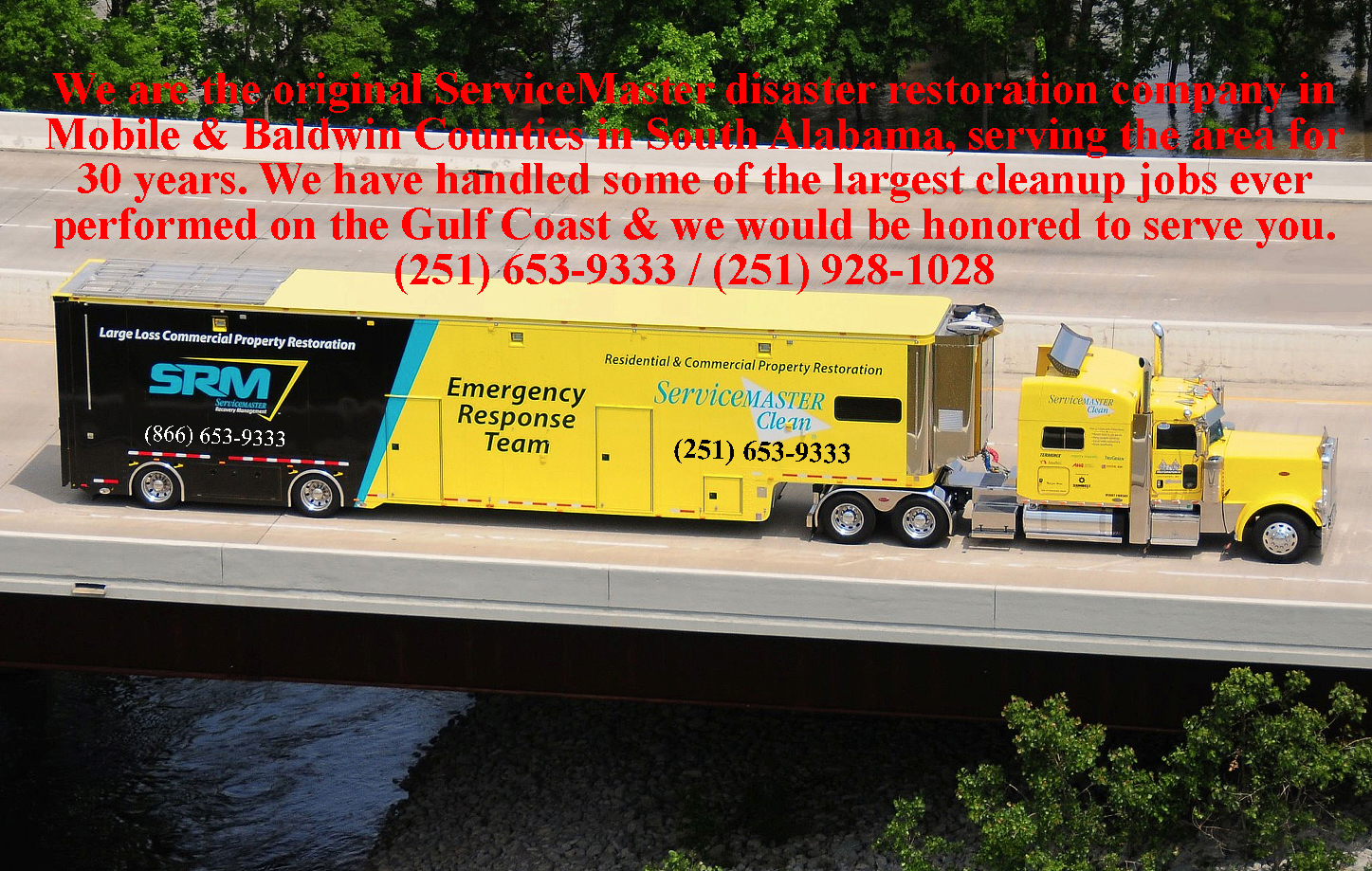


Below are more actual pictures of large loss industrial and commercial water damage restoration and commercial fire restoration jobs actually performed by ServiceMaster Advanced Cleaning & Restoration and the ServiceMaster Recovery Management (SRM) Network. Unlike many other small or regional players, we have actually performed this work for many years, and we know how to handle a large commercial loss from start to finish. We have consistently brought projects like this in, on-time and on-budget, with our goal to minimize disruption to the affected businesses and bring them back to working status as fast as humanly possible. Some of these jobs, and many others, were awarded to us after a competitor was terminated because they couldn't deliver.
.jpg)

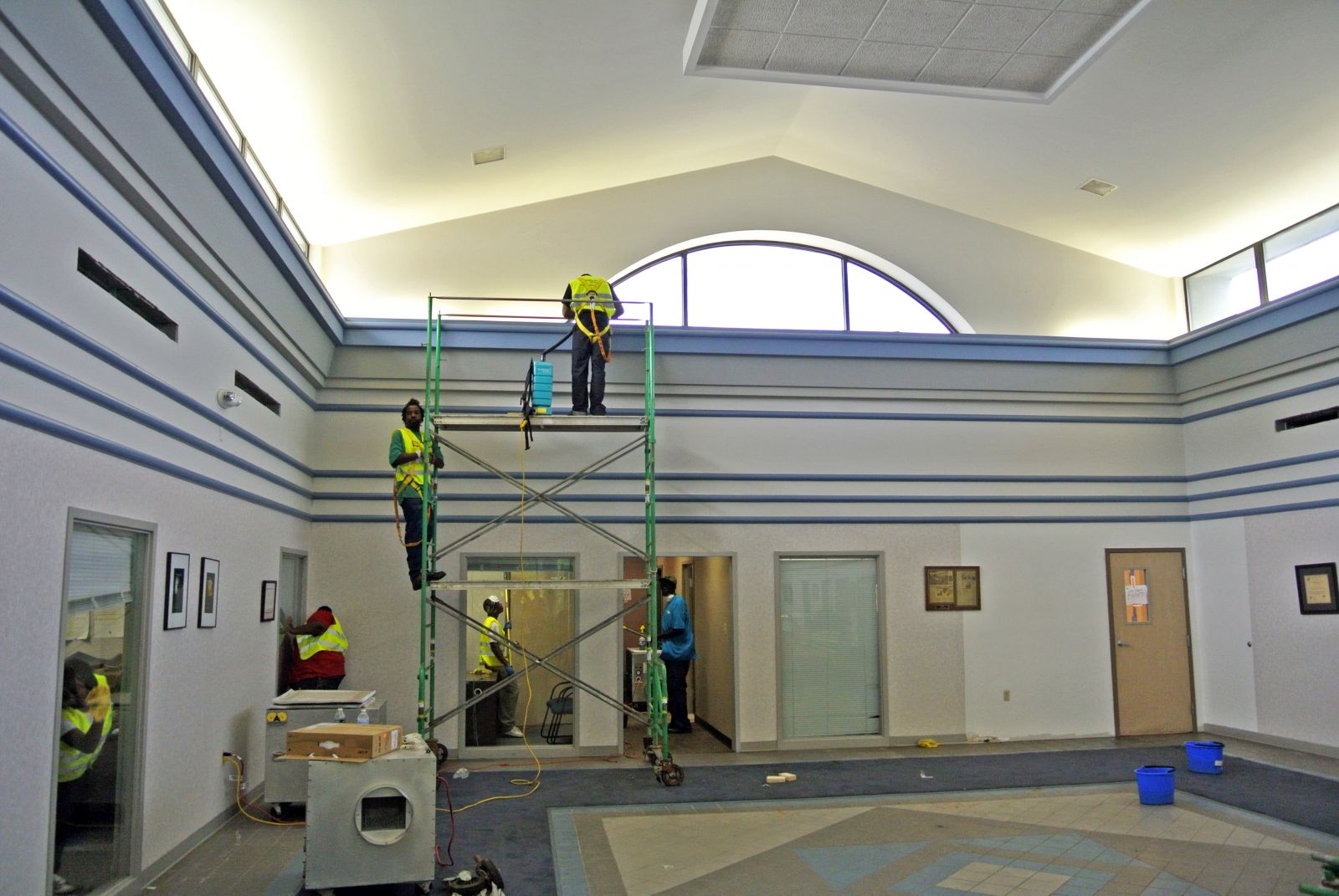

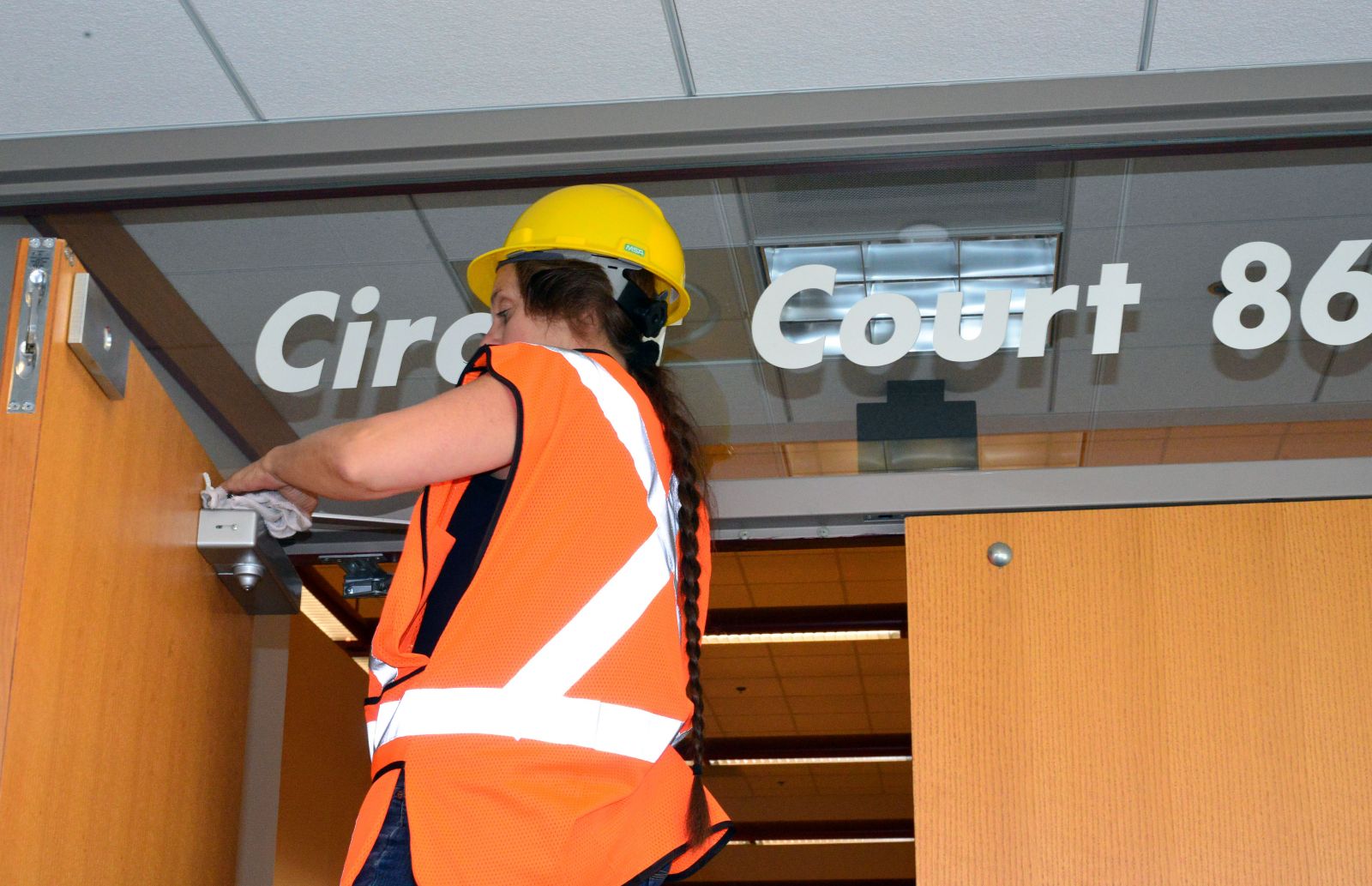

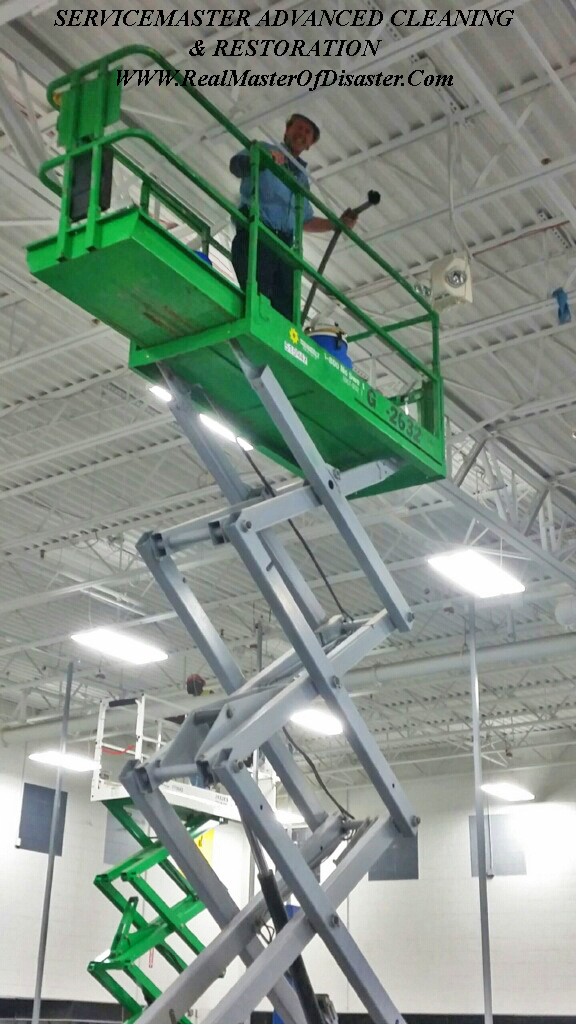
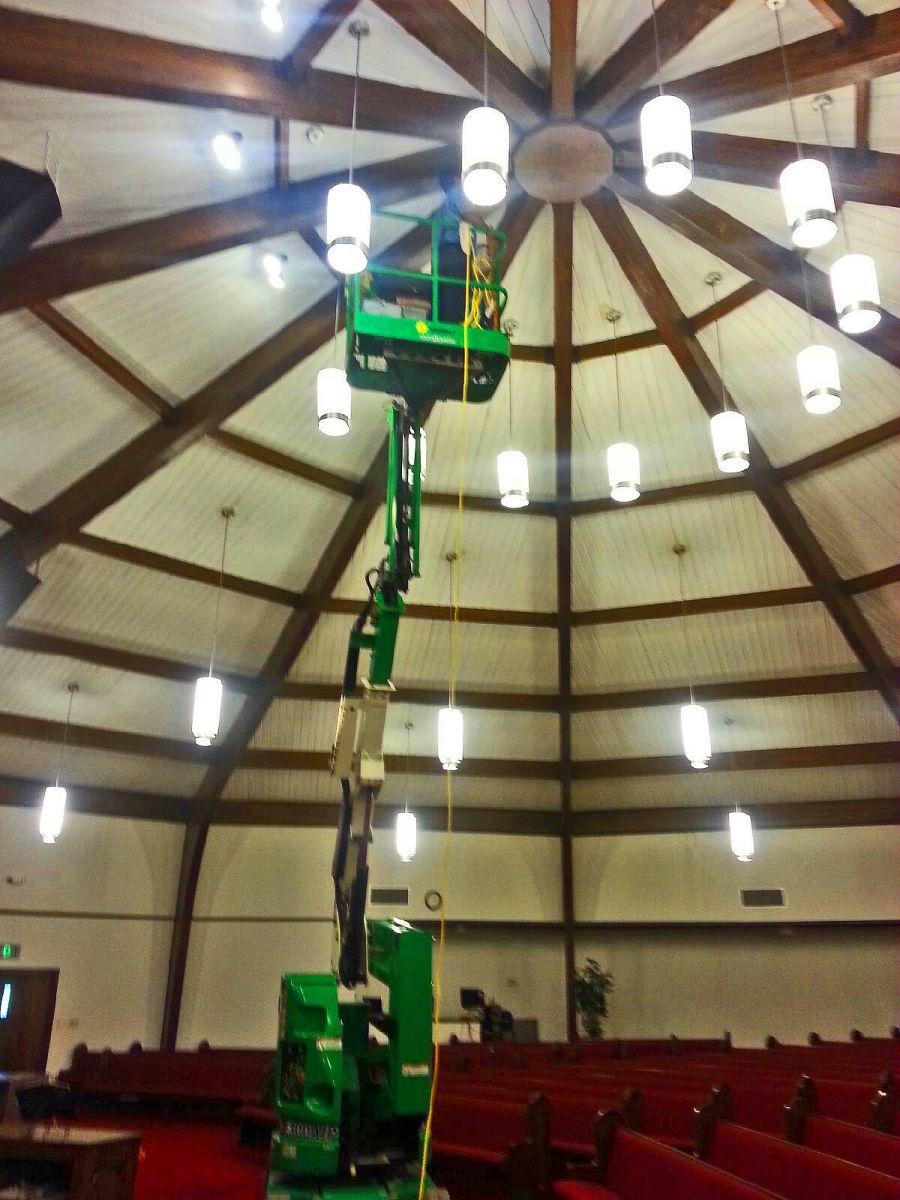

.jpg)




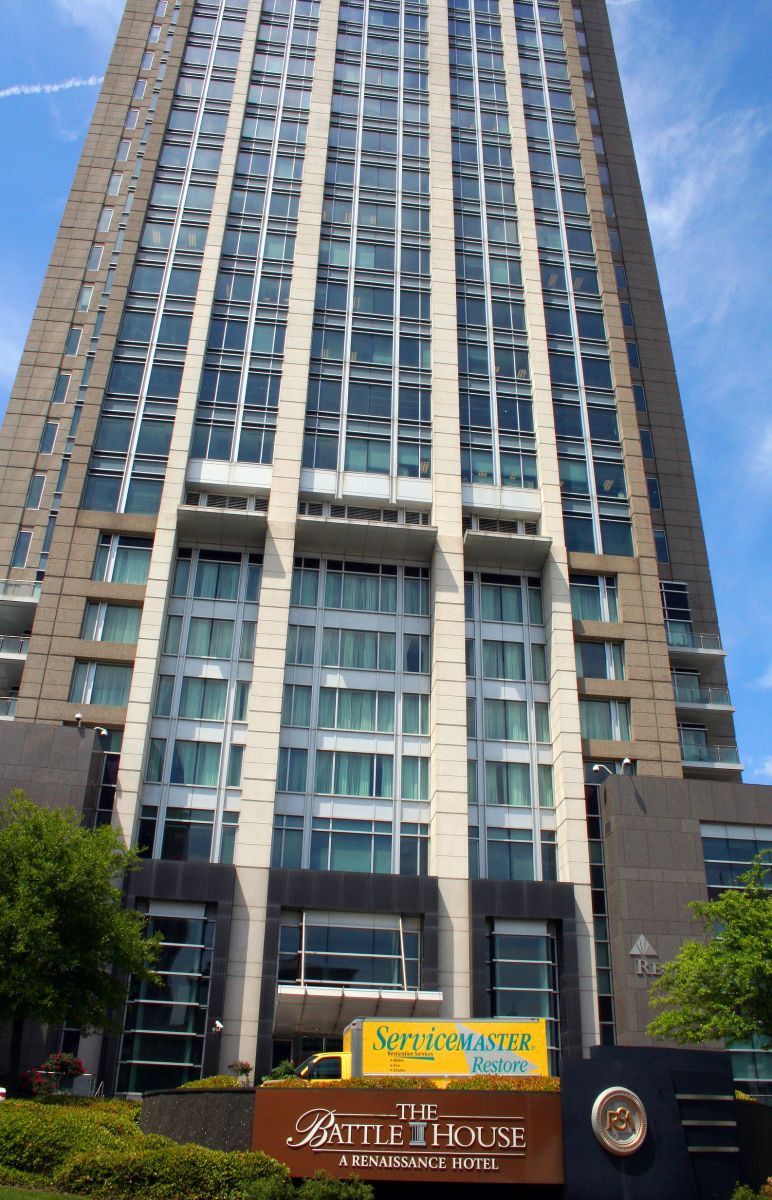




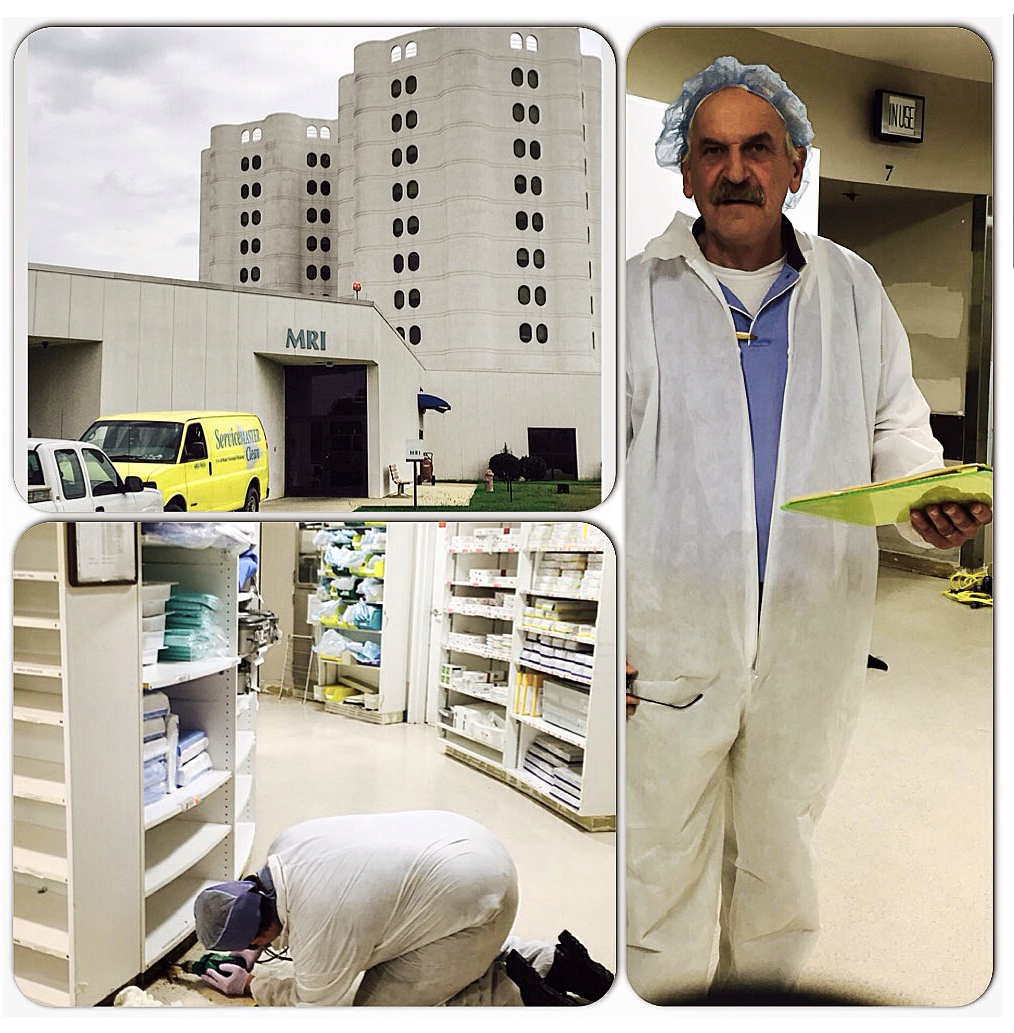






.jpg)

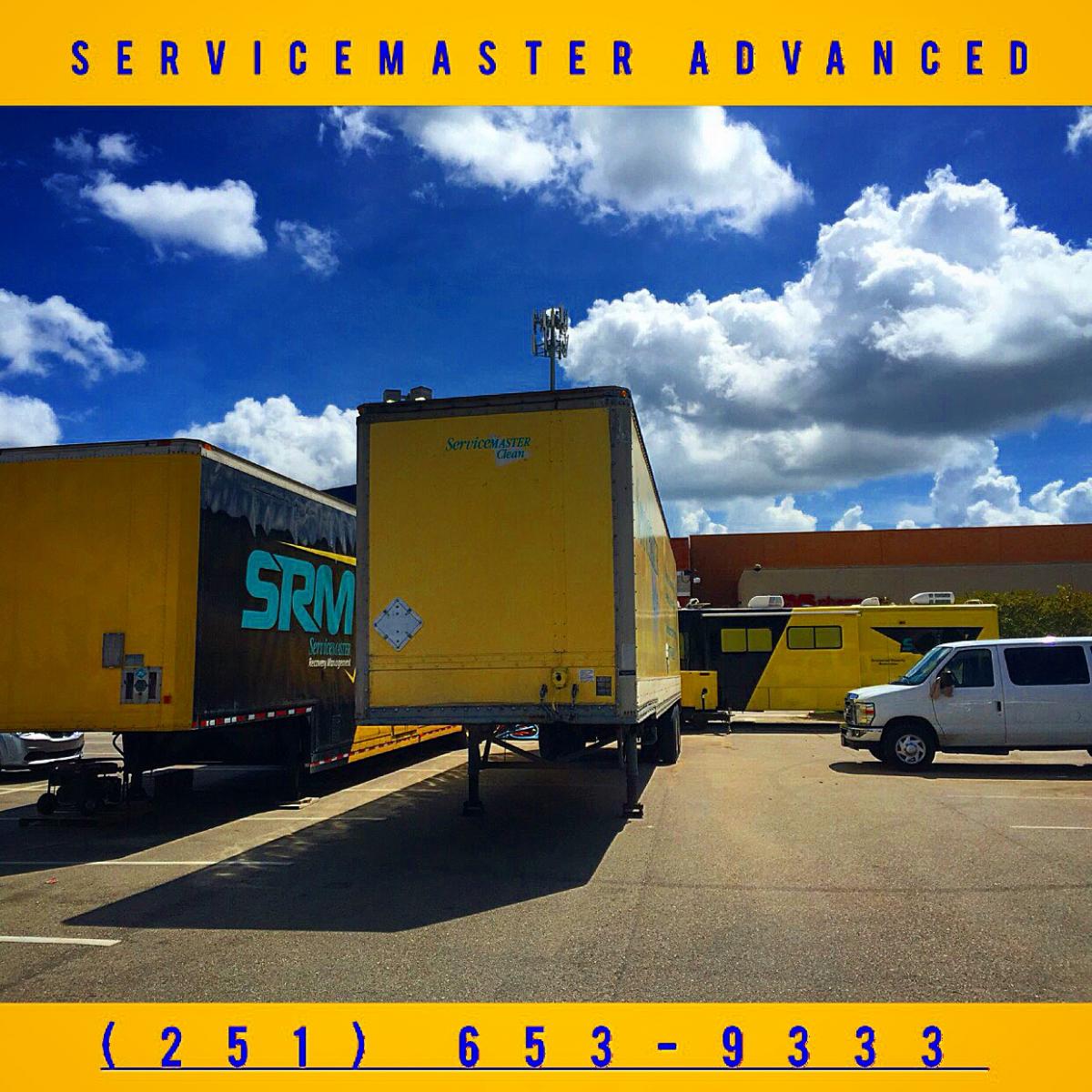

ServiceMaster Advanced Cleaning and Restoration (251) 653-9333, is proud to be a first responder for the ServiceMaster Recovery Management Network, (SRM). As one of the largest commercial disaster recovery networks in the nation, SRM has handled incredible large loss restoration projects. The successful jobs handled include large universities, school systems, indoor arenas, large commercial buildings and government buildings. In fact, ServiceMaster even performed restoration work on the Pentagon after the September 11, 2001 crisis. There is no water damage, fire or commercial water damage restoration job too big for our restoration team.

Over the years, we have seen large commercial entities become contractually obligated to utilize the services of a large loss provider, even if this means that they had to wait five hours or more for the provider to arrive. ServiceMaster knows that every minute that you are not back in business, translates to time and money wasted. This is why over ten years ago, ServiceMaster responded to the immediate needs of the commercial industry by the creation of the ServiceMaster Recovery Network.
In the Southeast, SRM has every major city covered with first responders who can immediately assess, neutralize and begin restoration services. In short, work can begin immediately. In Mobile and Baldwin Counties in South Alabama, and in Mississippi, ServiceMaster Advanced Cleaning & Restoration and ServiceMaster Services, can immediately put dozens of workers on the site and begin services. We already have hundreds of employees and existing relationships with contract providers. We are not arriving from out of town, with no idea who to hire - our employees already work for us! Not all ServiceMaster entities are trained and designated as first responders for the SRM network, and most restoration companies cannot even begin to handle even the smallest commercial loss. So make certain that you call a commercial certified ServiceMaster company like ServiceMaster Advanced, (251) 653-9333.


Remember that YOU AND YOU ALONE, decide who works in your business. YOU decide who can turn the job the fastest, and get your business facility back up and running the soonest. This is not the decision of your insurance provider. And while sometimes the insurance companies have qualified providers; other times they do not. Tell your insurance provider WHEN YOU FILE YOUR CLAIM that you want SERVICEMASTER ADVANCED, Enterprise number 7027, or call us directly. Make sure that there is no confusion. There are other mitigation companies, and even others with similar sounding names. We are ServiceMaster Advanced, The Master of Disaster. "WE WOULD BE HONORED TO SERVE YOU." (251) 653-9333, (251) 928-1028 (251) 943-2230 or (866) 653-9333. http://www.servicemastermobile.com http://www.servicemasterbaldwincounty.com
